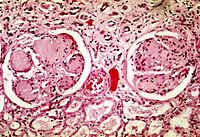
Photo from wikipedia
Several clinical studies have shown the beneficial effects of sodium-glucose cotransporter 2 (SGLT2) inhibitors on diabetic nephropathy. The underlying mechanisms are not fully understood. We found that administration of canagliflozin… Click to show full abstract
Several clinical studies have shown the beneficial effects of sodium-glucose cotransporter 2 (SGLT2) inhibitors on diabetic nephropathy. The underlying mechanisms are not fully understood. We found that administration of canagliflozin at a low dose (0.01 mg/kg/day) did not affect either blood glucose levels or glycosuria, but it improved albuminuria and mesangial expansion in db/db mice to a similar extent as at a high dose (3.0 mg/kg/day) that lowered blood glucose levels. This indicated the existence of a tubular SGLT2-independent reno-protective mechanism. Here we focused on the potential role of SGLT2 in mesangial cells (MCs). Western blot analysis revealed the expression of SGLT2 in cultured mouse MCs. Exposure of MCs to high glucose levels for 72 h significantly increased the expression of SGLT2. Canagliflozin or ipragliflozin (both 100 nM) treatment inhibited glucose consumption in the medium under high-glucose conditions but not under normal-glucose conditions. Furthermore, canagliflozin inhibited high-glucose-induced activation of the protein kinase C (PKC)-NAD(P)H oxidase pathway and increases in reactive oxygen species (ROS) production. Thus, the inhibition of mesangial SGLT2 may cause an inhibition of PKC activation and ROS overproduction in diabetic nephropathy, and this may at least in part account for the reno-protective effect of SGLT2 inhibitors.
Journal Title: Scientific Reports
Year Published: 2019
Link to full text (if available)
Share on Social Media: Sign Up to like & get
recommendations!